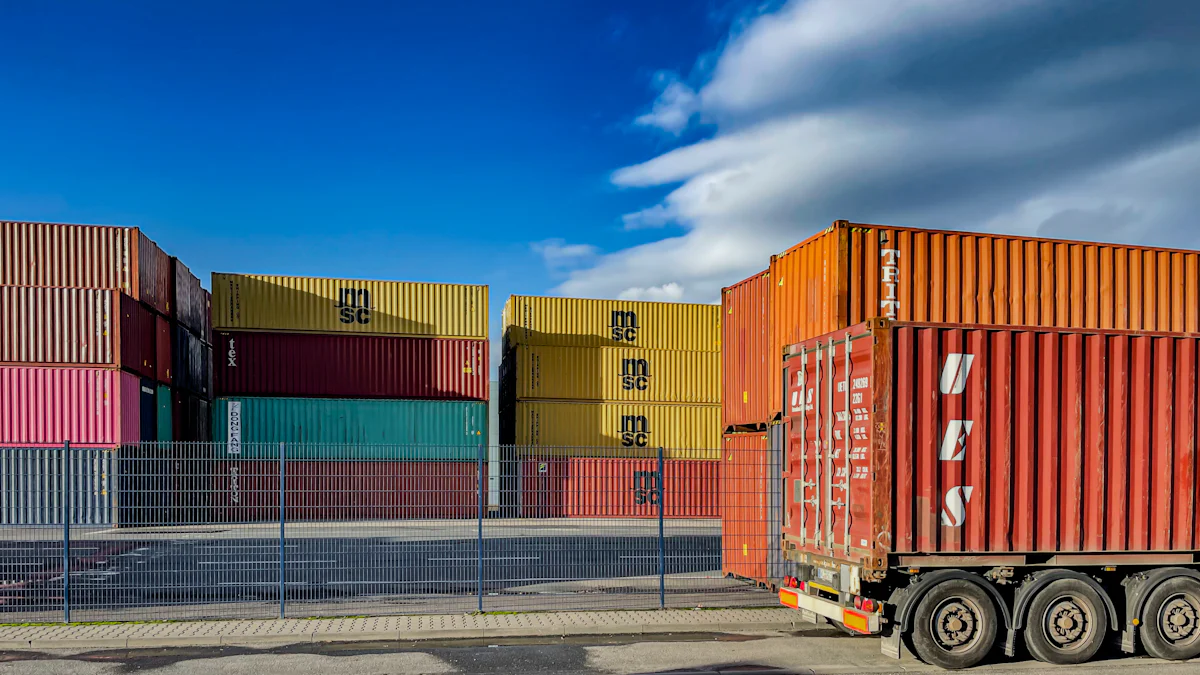How to Boost Supply Chain Visibility and Performance

Supply chain visibility plays a crucial role in enhancing your business performance. It offers benefits like improved efficiency, reduced lead times, and better decision-making. Companies with strong supply chains often see above-average revenue growth. However, challenges such as data silos and lack of real-time information persist. Innovative solutions like JusLink address these issues by integrating IoT and big data, enabling real-time collaboration and risk management. By adopting these technologies, you can optimize inventory and enhance customer service, ensuring a competitive edge in the market.
Understanding Supply Chain Visibility
Definition and Importance
Supply chain visibility refers to the ability to track and monitor every aspect of your supply chain in real-time. This includes inventory levels, shipment status, and logistics processes. Enhanced visibility offers several key benefits:
Key benefits of enhanced visibility
Operational Efficiency: You can streamline operations by having a clear view of your supply chain. This reduces waste and improves productivity.
Risk Mitigation: With better visibility, you can identify potential disruptions early and take proactive measures to mitigate risks.
Customer Satisfaction: Real-time tracking allows you to provide accurate delivery updates, enhancing customer trust and satisfaction.
Impact on decision-making
Supply chain visibility significantly impacts decision-making. When you have access to real-time data, you can make informed decisions quickly. This agility helps you respond to market changes and customer demands effectively. Companies with strong visibility often outperform their competitors by adapting swiftly to new challenges.
Current Challenges
Despite its importance, achieving full supply chain visibility presents several challenges:
Data silos
Data silos occur when information is isolated within different departments or systems. This fragmentation hinders your ability to gain a comprehensive view of the supply chain. Breaking down these silos requires integrating data across all platforms, ensuring seamless information flow.
Lack of real-time information
Without real-time information, you may face delays in identifying issues or opportunities. This lag can lead to inefficiencies and missed chances for improvement. Implementing technologies like IoT sensors and AI can help you gather and analyze data in real-time, enhancing your supply chain visibility.
Strategies to Enhance Supply Chain Visibility

Enhancing supply chain visibility is essential for optimizing your operations. By implementing the right strategies, you can achieve greater transparency and efficiency.
Implementing Technology Solutions
Role of IoT and AI
IoT and AI play a pivotal role in transforming supply chain visibility. These technologies provide real-time insights, allowing you to track inventory, shipments, and logistics processes seamlessly. IoT devices, such as sensors and RFID tags, collect data continuously. This data feeds into AI systems that analyze and predict trends, enhancing decision-making.
Research shows: AI and IoT empower supply chain operations with predictive analytics and automation, leading to improved efficiency and agility.
By integrating IoT and AI, you can automate routine tasks and optimize resource allocation. This not only boosts operational resilience but also ensures a more responsive supply chain.
Benefits of using JusLink
JusLink offers a comprehensive solution for enhancing supply chain visibility. It integrates IoT, cloud computing, and big data to provide a unified platform for real-time collaboration. With JusLink, you gain access to accurate and timely information, enabling better risk management and customer satisfaction.
Real-time Tracking: Monitor shipments and inventory levels instantly.
Predictive Analytics: Anticipate disruptions and adjust strategies proactively.
Enhanced Collaboration: Foster seamless communication across all supply chain partners.
Data Integration and Management
Importance of centralized data
Centralized data is crucial for achieving full supply chain visibility. When you consolidate information from various sources into a single system, you eliminate data silos. This unified access allows you to make informed decisions quickly and efficiently.
Key Insight: Establishing a centralized data system enables unified access to information, enhancing overall supply chain management.
Overcoming integration challenges
Integrating diverse data sources can be challenging. However, overcoming these obstacles is vital for improving supply chain visibility. You must focus on creating a robust infrastructure that supports seamless data flow. This involves selecting compatible technologies and ensuring that all systems communicate effectively.
Identify Pain Points: Recognize areas where data integration is lacking.
Choose the Right Tools: Opt for technologies that facilitate smooth data exchange.
Continuous Monitoring: Regularly assess and refine integration processes.
By addressing these challenges, you can build a more transparent and efficient supply chain, ultimately leading to better performance and competitiveness.
Improving Supply Chain Performance
Key Performance Indicators (KPIs)
Identifying relevant KPIs
To enhance supply chain performance, you must identify the right Key Performance Indicators (KPIs). These metrics help you measure efficiency and effectiveness. Focus on KPIs that align with your business goals. Common KPIs include order accuracy, delivery time, and inventory turnover. By selecting relevant KPIs, you can track progress and pinpoint areas for improvement.
Case Study: Whirlpool Whirlpool engaged with a logistics service provider to refine their KPI management. They focused on delivery accuracy and customer satisfaction, leading to improved logistics performance.
Monitoring and analysis
Once you've identified KPIs, consistent monitoring is crucial. Regularly analyze data to understand trends and patterns. This helps you make informed decisions and adjust strategies as needed. Use dashboards and reports to visualize performance. By keeping a close eye on KPIs, you can ensure your supply chain remains agile and responsive.
Insight: An executive's guide to supply chain management emphasizes the importance of continuous KPI analysis for strategic decision-making.
Process Optimization
Lean management techniques
Lean management techniques streamline operations by eliminating waste. Focus on value-added activities and reduce unnecessary steps. Implementing lean practices can lead to faster processes and lower costs. Techniques like Just-In-Time (JIT) inventory and 5S organization enhance efficiency. By adopting lean methods, you create a more efficient supply chain.
Continuous improvement strategies
Continuous improvement involves regularly evaluating and refining processes. Encourage a culture of innovation where employees suggest improvements. Use tools like Kaizen to foster small, incremental changes. This approach leads to sustained growth and adaptability. By prioritizing continuous improvement, you ensure your supply chain evolves with market demands.
Tip: Regularly review processes and encourage feedback to drive ongoing enhancements in supply chain performance.
Real-World Applications

Exploring real-world applications of supply chain visibility can provide valuable insights into its transformative potential. By examining case studies and success stories, you can understand how businesses have leveraged visibility to enhance their operations.
Case Studies
Successful implementation of JusLink
JusLink has revolutionized supply chain visibility for many companies. One notable example involves a leading electronics manufacturer that faced challenges with inventory management and shipment tracking. By implementing JusLink, the company achieved real-time visibility across its supply chain. This integration allowed them to monitor inventory levels accurately and track shipments efficiently. As a result, they reduced lead times and improved customer satisfaction.

SMART JusLink
Supply Chain Management Solution
Real-time Monitoring: Enabled precise tracking of inventory and shipments.
Improved Efficiency: Streamlined operations and reduced delays.
Enhanced Customer Experience: Provided accurate delivery updates, boosting customer trust.
Lessons learned from industry leaders
Industry leaders have demonstrated the importance of embracing supply chain visibility. A key lesson is the need for proactive communication with suppliers and stakeholders. By fostering open lines of communication, you can ensure that all parties have access to the same information, reducing misunderstandings and enhancing collaboration.
Insight: Proactive communication with suppliers significantly enhances supply chain visibility, leading to better coordination and efficiency.
Success Stories
Companies that transformed their supply chains
Several companies have successfully transformed their supply chains by prioritizing visibility. For instance, a global FMCG company faced challenges with demand forecasting and inventory management. By adopting advanced technologies like IoT sensors and centralized data systems, they gained comprehensive visibility into their supply chain. This transformation enabled them to optimize inventory levels and respond swiftly to market changes.
IoT Integration: Provided real-time data for accurate demand forecasting.
Centralized Data Systems: Eliminated data silos, ensuring seamless information flow.
Responsive Supply Chain: Adapted quickly to market demands, enhancing competitiveness.
Measurable outcomes and benefits
The benefits of enhanced supply chain visibility are measurable and impactful. Companies that have embraced visibility report significant improvements in operational efficiency and customer satisfaction. For example, a logistics provider using JusLink achieved a 20% reduction in lead times and a 15% increase in on-time deliveries. These outcomes demonstrate the tangible advantages of investing in visibility solutions.
Reduced Lead Times: Streamlined processes for faster deliveries.
Increased On-Time Deliveries: Improved reliability and customer trust.
Operational Efficiency: Enhanced productivity and cost savings.
By learning from these real-world applications, you can understand the critical role of supply chain visibility in driving performance and competitiveness. Embracing these strategies can position your business for success in an ever-evolving market landscape.
Addressing Challenges and Gaps
Enhancing supply chain visibility often involves overcoming specific challenges. Understanding these obstacles and implementing effective solutions can significantly improve your supply chain operations.
Common Obstacles
Resistance to change
You might encounter resistance when introducing new technologies or processes. Employees may feel uncertain about changes, fearing disruptions to their routines. To address this, communicate the benefits clearly. Show how enhanced supply chain visibility leads to better efficiency and job satisfaction. Encourage open dialogue and provide training to ease the transition.
Budget constraints
Budget limitations can hinder your efforts to improve supply chain visibility. Investing in new technologies may seem costly initially. However, consider the long-term benefits. Enhanced visibility reduces inefficiencies and lowers operational costs. Prioritize investments that offer the highest return. Demonstrating potential savings can help justify the expenditure.
Solutions and Recommendations
Building a culture of innovation
Fostering a culture of innovation is crucial for improving supply chain visibility. Encourage your team to embrace new ideas and technologies. Create an environment where experimentation is welcomed. Recognize and reward innovative solutions that enhance visibility. This approach not only boosts morale but also drives continuous improvement.
Strategic investment in technology
Invest strategically in technology to enhance supply chain visibility. Focus on tools that offer real-time data and analytics. IoT devices and AI systems provide valuable insights into your operations. Choose technologies that integrate seamlessly with existing systems. This ensures a smooth transition and maximizes the benefits of enhanced visibility.
By addressing these challenges and implementing these strategies, you can significantly improve your supply chain visibility. This leads to more efficient operations and a stronger competitive position in the market.
Boosting supply chain visibility and performance requires strategic actions. By implementing technologies like AI and IoT, you can enhance efficiency and responsiveness. These tools provide real-time data, enabling data-driven decision-making and agile responses to market changes. Embrace innovative solutions to uncover hidden issues and optimize operations. Cultivating a culture of transparency and accountability is essential for a truly visible supply chain. As you adopt these strategies, you position your business for future success in an ever-evolving market landscape.
See Also
The Power of Visibility in Enhancing Supply Chain Efficiency
Consistent Transparency: Essential for Supply Chain Excellence
Realizing the Strength of Your Automotive Supply Chain
Optimizing Performance: JUSDA's Comprehensive Supply Chain Visibility
Driving Growth: How Supply Chain Visibility Impacts Global E-commerce
